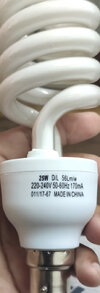The compact fluorescent was no where near as efficient as the straight tube, however the LED also varies a lot, I have two boxes for smart GU10 bulbs on my desk, one 5.5 watt with 345 lumen, the other 5 watt with 500 lumen, odd the latter is colour changing so would have expected to have been the worst of two.
But the first one at 63 lumen per watt is likely worse than the compact fluorescent. I have a 7 watt GU10 compact fluorescent but no lumen marked on the bulb. Have found advert for 9 watt CFL GU10 with 200 lumen which is very poor at 23 lumen per watt, so clearly not good but the quartz version 50 watt at 500 lumen down to 10 lumen per watt, I have kept to GU10 so you can compare.
The problem with fluorescent is over time the output falls off, the one GU10 CFL still works, but more like a toc H candle. But as to if worth replacing, hard to say, we had some really poor Philips E14 golf ball CFL 8 watt each, now replaced with 5 watt LED, but although now room is brighter, saving between 5 and 8 watt is not very much, and the life of a bulb seems to be so variable it is impossible to calculate costs.
Looking at adverts 5.5 watt LED = 9 watt CFL approx. Hardly worth worrying about.




